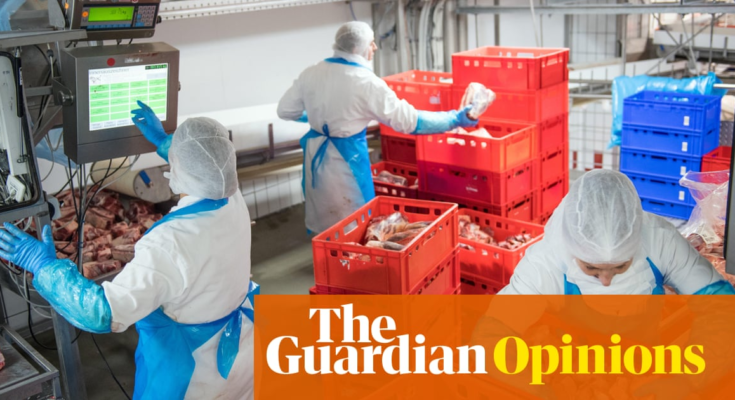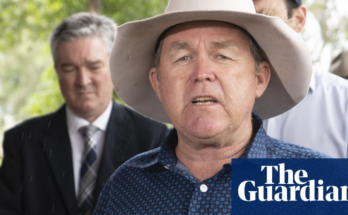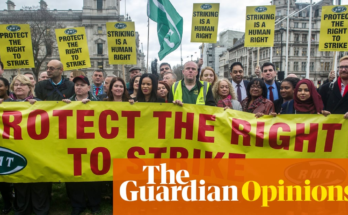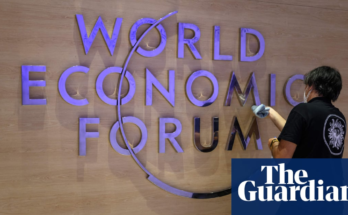A Guardian investigation reveals exploitation is rife in the meat industry, while also being a major source of greenhouse gases. Yet we still subsidise it
Thu 30 Sep 2021 06.21 EDT
The case for cutting meat consumption is so compelling that you would think politicians would be less shy about making it. Yet while campaigners warn with increasing urgency that global livestock production is accelerating climate breakdown and causing devastating damage to nature and human health, governments remain reluctant to tackle meat-eating.
Industrial livestock systems designed to extract ever greater commercial value from farmed animals have repeatedly been shown to depend on cruelty to animals and the armies of workers processing them.
The reality is that if we eat meat at all, we need to eat less and better-reared produce. That sort of produce costs dramatically more. With food poverty such a huge problem in the UK and other developed economies, not just for those on welfare but for those in low-paid work, proposing anything that would make food more expensive has become politically impossible.
Our attitude to meat-eating goes beyond economics and the 21st-century rise of the “precariat”, however. The desire for meat is deeply embedded in western culture. A hierarchy of protein has been established through the centuries. Chunks of meat, and especially beef, were what the overlords ate and grew tall on through the ages, and what those underneath them in the pecking order aspired to. Beans and bones were the stuff of peasant cooking.
Animal foods have been long promoted as superior as the source of “complete” protein, containing in one package all the amino acids we need for the body’s building blocks. Plant food that only contained some of them, or needed to be eaten in combination to obtain all of them, was seen as inferior.
Protein deficiencies are rare in developed countries and most of us, including vegetarians, eat much more than we need. Yet the cultural preferences persist.
Food is also all about class. Few people welcome a lecture from wealthy political elites about cutting out cheap chicken and burgers or the slosh of milk on breakfast cereal.
George Orwell worried about the quality of diets of the English working class in the 1930s. “A man dies and is buried, and all his actions forgotten, but the food he has eaten lives after him in the sound or rotten bones of his children,” he wrote in his Depression-era book, The Road to Wigan Pier.
But he chided those who would tell them to spend their money on more wholesome food. “A millionaire may enjoy breakfasting off orange juice and Ryvita biscuits; an unemployed man doesn’t … When you are underfed, harassed, bored and miserable, you don’t want to eat dull, wholesome food. You want something a little bit ‘tasty’. There is always some cheaply pleasant thing to tempt you. Let’s have three pennorth of chips!” Or translated to today’s culture: make mine a quarter pounder with fries!
There is a powerful streak of nationalism at work here too. Roast beef is an age-old symbol of John Bull and British freedom. Hogarth encapsulated the notion in his 18th-century paintings and prints, titled O the Roast Beef of Old England. Hogarth was a member of the Sublime Society of Beefsteaks, which met for ritual meals of rare beef accompanied by the singing of songs deriding the weak and weedy French, who ate miserable frogs instead. The sentiment was alive and well into the 21st century. Until the crash, a group of financiers specialising in “structured finance” – that is large-scale tax-avoidance arrangements – regularly met for ritual beef binges as the “Cow Eating Club”.
Meat, preferably red and still bloody, is still a symbol of power and machismo. And a limitless supply of cheap meat for all – thanks to new trade deals – is one of the benefits of our departure from the EU promoted by Brexiters: British liberty tied up with meat once more.
But this is all back to front. The meat on offer today is not so much John Bull as the ubiquitous American hamburger, or American-style southern fried chicken. It is highly processed food that is linked to a range of diet-related diseases. Our taste for meat in the form and quantity in which it is currently consumed is shaped by the power of advertising and subsidy.
Fast-food companies are among the biggest spenders on advertisements. Beef and milk production are not only among the biggest sources of greenhouse gas emissions, but also the biggest recipients of subsidies. Not much free market or free choice there. A new UN report estimates that almost 90% of the $540bn (£400bn) a year given by governments in subsidies to farmers are damaging for the climate, our health and ecosystems.
What looks cheap is cheap largely thanks to taxpayers’ money and the shrinking share of GDP paid out as wages. The cultural associations of meat-eating may go back through the ages, but the habits of mass consumption are recently acquired. There is another way.
Sign up for the Animals farmed monthly update to get a roundup of the best farming and food stories across the world and keep up with our investigations. You can send us your stories and thoughts at [email protected]
{{topLeft}}
{{bottomLeft}}
{{topRight}}
{{bottomRight}}
{{/ticker}}
{{heading}}
{{#paragraphs}}
{{.}}
{{/paragraphs}}{{highlightedText}}



